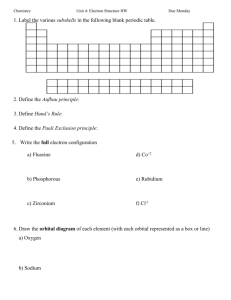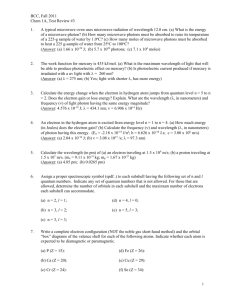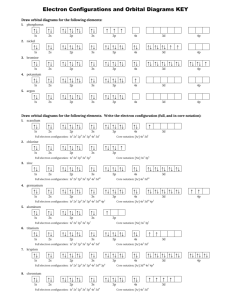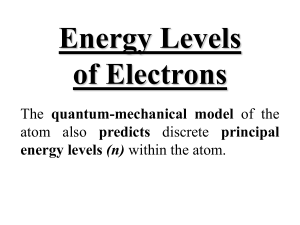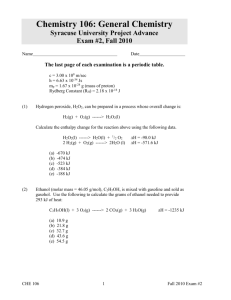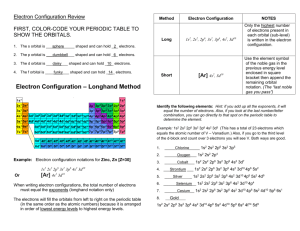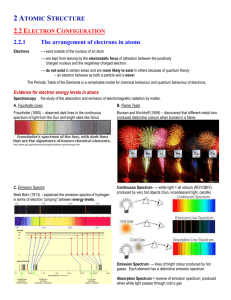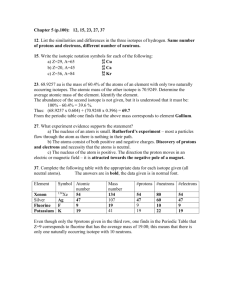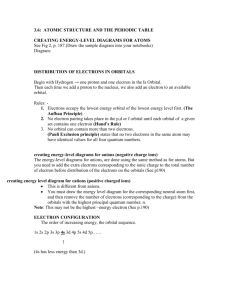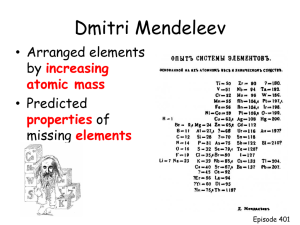File
advertisement
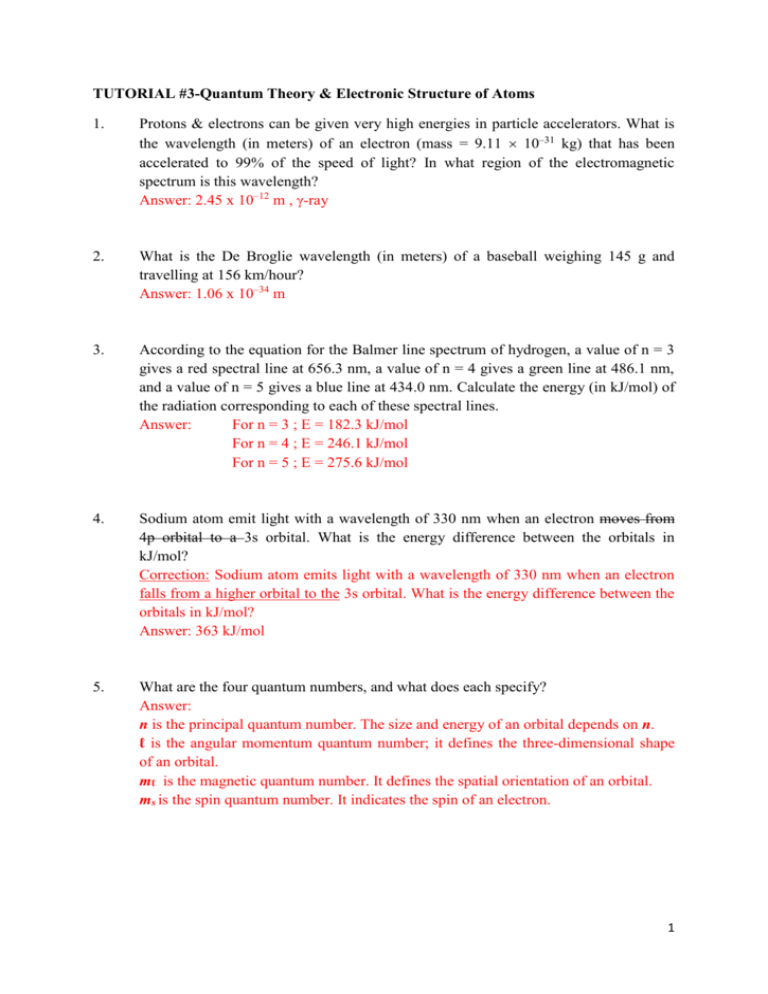
TUTORIAL #3-Quantum Theory & Electronic Structure of Atoms 1. Protons & electrons can be given very high energies in particle accelerators. What is the wavelength (in meters) of an electron (mass = 9.11 10–31 kg) that has been accelerated to 99% of the speed of light? In what region of the electromagnetic spectrum is this wavelength? Answer: 2.45 x 10–12 m , γ-ray 2. What is the De Broglie wavelength (in meters) of a baseball weighing 145 g and travelling at 156 km/hour? Answer: 1.06 x 10–34 m 3. According to the equation for the Balmer line spectrum of hydrogen, a value of n = 3 gives a red spectral line at 656.3 nm, a value of n = 4 gives a green line at 486.1 nm, and a value of n = 5 gives a blue line at 434.0 nm. Calculate the energy (in kJ/mol) of the radiation corresponding to each of these spectral lines. Answer: For n = 3 ; E = 182.3 kJ/mol For n = 4 ; E = 246.1 kJ/mol For n = 5 ; E = 275.6 kJ/mol 4. Sodium atom emit light with a wavelength of 330 nm when an electron moves from 4p orbital to a 3s orbital. What is the energy difference between the orbitals in kJ/mol? Correction: Sodium atom emits light with a wavelength of 330 nm when an electron falls from a higher orbital to the 3s orbital. What is the energy difference between the orbitals in kJ/mol? Answer: 363 kJ/mol 5. What are the four quantum numbers, and what does each specify? Answer: n is the principal quantum number. The size and energy of an orbital depends on n. ℓ is the angular momentum quantum number; it defines the three-dimensional shape of an orbital. mℓ is the magnetic quantum number. It defines the spatial orientation of an orbital. ms is the spin quantum number. It indicates the spin of an electron. 1 6. Which of the following combinations of quantum numbers are not allowed? Explain your answer. (a) n = 3, ℓ = 0 , mℓ = –1 (b) n = 3, ℓ = 1 , mℓ = +1 (c) n = 4, ℓ = 4 , mℓ = 0 Answer: (a) not allowed because when ℓ = 0 , mℓ = 0 only (b) allowed (c) not allowed because when n = 4, ℓ = 0, 1, 2 and 3 only 7. In a multi electron atom, which orbital of the following pairs is higher in energy? (a) 5p or 5d? (b) 4s or 3p? (c) 6s or 4d? Answer: (a) 5d ; (b) 4s ; (c) 6s 8. Write the ground state electron configurations for the following elements: (a) Ti (c) Sn (e) Se (b) Ru (d) Sr Answer: (a) 1s2 2s2 2p6 3s2 3p6 4s2 3d2 (b) 1s2 2s2 2p6 3s2 3p6 4s2 3d10 4p6 5s2 4d6 (c) 1s2 2s2 2p6 3s2 3p6 4s2 3d10 4p6 5s2 4d10 5p2 (d) 1s2 2s2 2p6 3s2 3p6 4s2 3d10 4p6 5s2 (e) 1s2 2s2 2p6 3s2 3p6 4s2 3d10 4p4 9. Draw the orbital diagram for the following atoms. Use the abbreviation of the preceding noble gas to represent inner-shell electrons. (a) Rb (c) Ge (b) W (d) Zr Answer: (a) Rb = [Kr] 5s1 (c) Ge = [Ar] 4s2 3d10 4p2 (b) W = [Xe] 6s2 4f14 5d4 (d) Zr = [Kr] 5s2 4d2 2 10. *An energetically excited hydrogen atom has its electron in a 5f subshell. The electron drops down to the 3d subshell, releasing a photon in the process. (a) Give the n and ℓ quantum numbers for both subshells, and give the range of possible mℓ quantum numbers. (b) What wavelength of light is emitted by the process? (c) The hydrogen atom now has a single electron in the 3d subshell. What is the energy (in kJ/mol) required to remove this electron? Answer: (a) 5f subshell: n =5, ℓ = 3, mℓ = -3, -2, -1, 0, +1, +2, +3 3d subshell: n = 3, ℓ = 2, mℓ = -2, -1, 0, +1, +2 (b) 1282 nm (c) 146 kJ/mol 3
